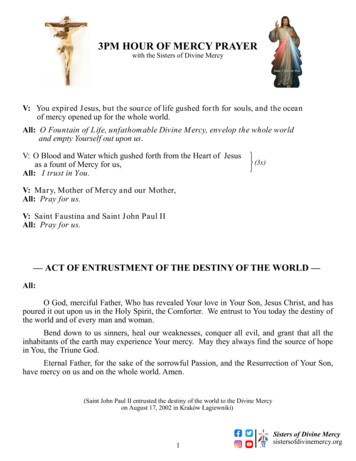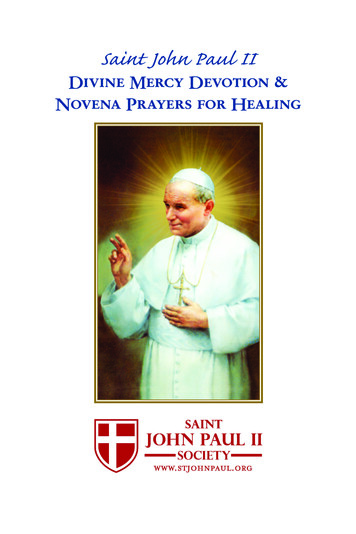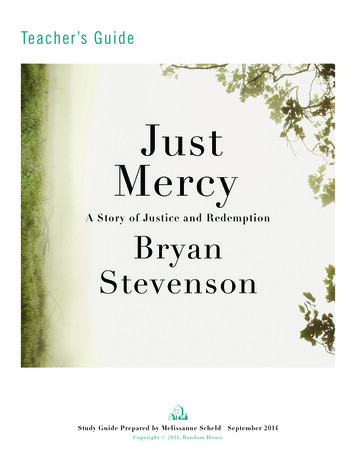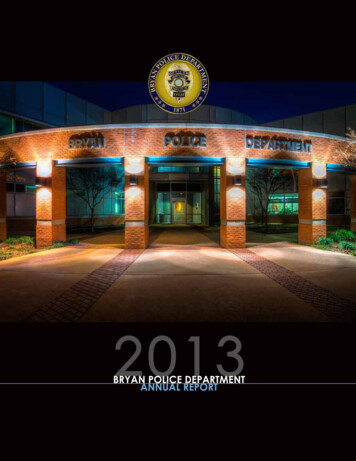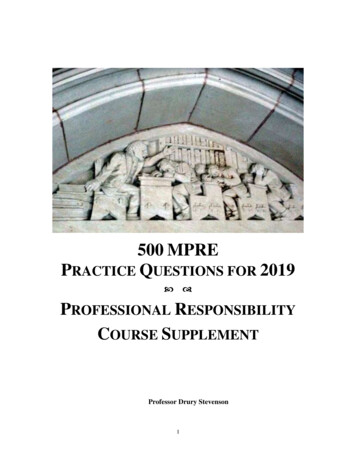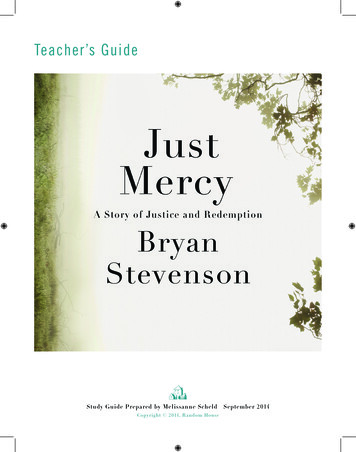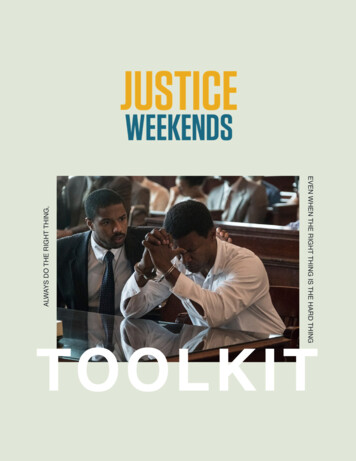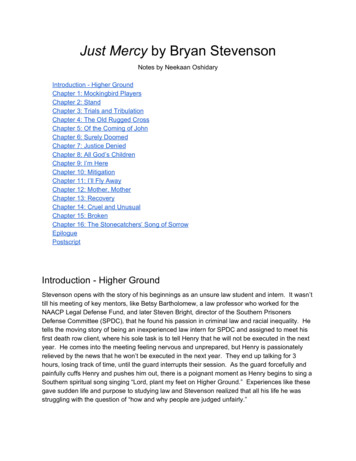
Transcription
Just Mercy by Bryan StevensonNotes by Neekaan OshidaryIntroduction Higher GroundChapter 1: Mockingbird PlayersChapter 2: StandChapter 3: Trials and TribulationChapter 4: The Old Rugged CrossChapter 5: Of the Coming of JohnChapter 6: Surely DoomedChapter 7: Justice DeniedChapter 8: All God’s ChildrenChapter 9: I’m HereChapter 10: MitigationChapter 11: I’ll Fly AwayChapter 12: Mother, MotherChapter 13: RecoveryChapter 14: Cruel and UnusualChapter 15: BrokenChapter 16: The Stonecatchers’ Song of SorrowEpiloguePostscriptIntroduction Higher GroundStevenson opens with the story of his beginnings as an unsure law student and intern. It wasn’ttill his meeting of key mentors, like Betsy Bartholomew, a law professor who worked for theNAACP Legal Defense Fund, and later Steven Bright, director of the Southern PrisonersDefense Committee (SPDC), that he found his passion in criminal law and racial inequality. Hetells the moving story of being an inexperienced law intern for SPDC and assigned to meet hisfirst death row client, where his sole task is to tell Henry that he will not be executed in the nextyear. He comes into the meeting feeling nervous and unprepared, but Henry is passionatelyrelieved by the news that he won’t be executed in the next year. They end up talking for 3hours, losing track of time, until the guard interrupts their session. As the guard forcefully andpainfully cuffs Henry and pushes him out, there is a poignant moment as Henry begins to sing aSouthern spiritual song singing “Lord, plant my feet on Higher Ground.” Experiences like thesegave sudden life and purpose to studying law and Stevenson realized that all his life he wasstruggling with the question of “how and why people are judged unfairly.”
Stevenson describes his upbringing in the Southern and racially segregated rural counties ofDelaware. His grandmother was the daughter of enslaved people, and she imprinted animportant lesson onto Stevenson that “You can’t understand most of the important things from adistance You have to get close”. Stevenson came to see that this closeness for him was thefight for justice of those judged unfairly.Stevenson outlines the great mass incarceration industrial complex and the extremepunishment so often delivered without fairness. We’ve gone from 300,000 people in prison inthe 1970s to 2.3 million today. 1 of 15 born in 2001 will go to prison, while 1 of 3 black babiesborn in this century will go to prison. Laws have made it increasingly easier to try children asadults and deliver life sentences without parole. The war on drugs has increased the number ofprisoners for drug offenses from 41,000 in 1980 to half a million today. On top of this, collateralconsequences on the incarcerated have included banning their access to food stamps (even forpoor women wanting to feed their children), public housing assistance or simply takingresidence in your family’s place or prior community, as well as voter disenfranchisement whichfor African Americans in some southern states has reached levels only present prior to theVoting Rights Act of 1965. The cost of mass incarceration has skyrocketed from 6.9 billionspent by the government in 1980 to 80 billion today. On top of this, the privatization of theprison industry leads to a vested interest in profiteering off mass incarceration.Stevenson still offers a sense of hope, “that there is light within this darkness, he says inspeaking about the case of Walter McMillian, a black man wrongly convicted on death row. Hiscase which will be covered in this book, highlights the “disturbing indifference to inaccurate orunreliable verdicts, our comfort with bias, and our tolerance to inaccurate or unreliable verdicts”.Stevenson ultimately concludes with the vital lesson he’s taken that “ Each of us is more than theworst thing we’ve ever done. ” The opposite of poverty is not wealth, but justice, he says. Heconcludes that a character of society and a nation is not how the treat the highest rungs ofsociety but “how we treat the poor, the disfavored, the accused, the incarcerated, and thecondemned.” “An absence of compassion can corrupt the decency of a community, a state, anation.”Chapter 1: Mockingbird PlayersStevenson tells the story of Walter McMillan, a black death row client of his, growing up inMonroe county in Alabama, home to the “Monroeville” of To Kill a Mockingbird. He opens with astrangely comical phone call he got from a judge by the name of Robert E. Lee Key. This judgewas telling Stevenson to drop his defense of McMillan, saying he had deep ties with drugdealing as “Dixie Mafia”. Instead, though we learn that when McMillan met Stevenson, heinsisted was innocent and framed. We learn more about McMillan’s upbringing in MonroeCounty. McMillan wisely saw that when Southern plantation owners shifted from cottom to thewood pulp and paper mill industry, black workers were especially at the mercy of the white
owners. Instead, McMillan industry started his own pulpwood cutting business, not earninggreat profits, but enough to be an independent and free worker.McMillan was not without his flaws, including a misdemeanor from a bar fight and being knownas a ladies man. But it was when he got involved with Karen Kelly, a white waitress who cameon to him, that he got mired in her ugly divorce, trial, and resultingly the public eye.Unfortunately, during this time two murders took place in the town, and one of the men in thecase suggesting McMillan was the murder of the victim, a daughter from a well respected family.The police were quite desperate at this point to find the murder, as the town had begun to lookdisfavorably on the seemingly inept sheriff and police.In telling this story, Stevenson describes the great fear and resistance in the South to interracialmarriage and sex. “Miscegenation laws” go back to the 1860s and were upheld by the SupremeCourt in 1880s, and it was common to expect lynching during this time when it was discoveredthat a black man was having relations with a white woman. It wasn’t till 1967 that the SupremeCourt shut down anti miscegenation laws, but even still such laws still existed in Stateconstitutions; in Alabama it wasn’t till 2000 that a ballot measure finally struck it down, by arelatively narrow margin. This sentiment undoubtedly played into the perception of McMillan’scase.Chapter 2: StandStevenson describes his early days as a lawyer, sleeping on his Steven Bright’s couch until hefinally mustered the time and money to move in with a friend of his in Atlanta. He thendescribes his huge case load working both for Alabama civil and criminal law while managingdeath penalty cases. He goes into the cruel punishment in prisons, including solitaryconfinement, “sweatboxes” where prisoners are confined in extreme heat for days or weeks, orchaining prisoners to “hitching posts” where there arms were fastened above their head and hadthem forced to stay there for hours (a practice that was declared unconstitutional till 2002).Exemplifying the brutal in prisons, Stevenson describes a case presented by the family ofLourida Ruffin. Ruffin was a large African American man who after being stopped for a trafficviolation, was beaten badly, thrown in a jail cell, and not provided for when we begged that heneeded his asthma inhaler and medication. He died in his cell that night, and while the prisonguards claimed natural causes, all the jailmates told a different story.Stevenson then tells a personal story in which he was wrongly held up by the police. After abusy night of work, he had the fortune of his finicky car stereo working as he listened to some ofhis favorite old tunes on the radio. When he arrived home he parked but kept listening to themusic he loved, but noting that he kept it low enough that nothing would be heard outside. TwoSWAT cops soon showed up and had him get out of the car, threatening to “Blow his head off” ifhe moved. Stevenson almost ran, but calmed down and assured the officers that all was ok and
that he lived here. The cops nonetheless illegally searched his car, and after finding nothing,they let him go. They said neighbors had called about a suspected burglar, as there had beenburglaries in the prior weeks. Stevenson tried to report the cops, writing out all the ways hisrights were violated, but nothing came of it.In retrospect, he realized how fortunate he was to not have “ran”, and thought about all the otheryoung black men who may have ran in fear. Stevenson ended talking to community groups andchurch gatherings on his work. In one church group, Stevenson got emotional, telling of hisrunup with the SWAT officers and their unjust treatment. As he was telling this, an old blackman in a wheelchair kept staring at him. At the end of the talk, he came up to him holding hisstare. He asked Stevenson “Do you know what you’re doing?” After Stevenson said “I thinkso,” the man broke the tension and said “You’re beating the drum of justice!” He told Stevensonto continue to beat the drum, and he showed him his 3 scars on his body, head, and face. Hesaid he got these protesting and fighting for civil rights, and that they weren’t scars, but his“medals of honor”.Chapter 3: Trials and TribulationThis chapter tells the story of McMillan’s unjust arrest, framing, and guilty verdict. Sheriff Tate,ABI investigators, and the DA realize that it’s too implausible to arrest McMillan on the groundsof murder of Morrison. But Ralph Myers, a severely burned white man known for his unreliablestories, builds on the suggestion of officers that he was assaulted by McMillan and concocts astory that McMillan sexually assaulted him. Tate seizes on this and arrests McMillan for“sodomy”. During his arrest, Tate and officers unashamedly throw racial epithets at McMillanand even bring up the recent lynching of a black man named Michael Donald, terrifyingMcMillan. Later officers get Myers to concoct an implausible story of robbery murder ofwhereby in mid day, McMillan walks up to Myers in a gas station, says his arm is injured andneeds to someone to drive him (despite being able to drive to the gas station), drives to thecrime scene, while Myers leaves to buy cigarettes elsewhere, and returns to have McMillancome out after killing the store clerk and having Myers drive him back to the gas station onlyafter threatening he’d kill him if he told anyone. Later Tate and investigators promise release toa black man, Bill Hooks, known as the jail snitch, if he helps incriminate McMillan in the Morrisonmurder. He says he saw their truck at the cleaners and saw the two men pull away. With thesetwo claims, they proceed to prosecute McMillan.McMillan however has a obvious alibi. During the day of the murder, his family and otherchurch goers were hosting a fish fry on his front lawn to raise funds for their church, whileMcMillan worked with a friend of his on fixing the transition of his car. Dozens of those at thefish fry were able to attest that McMillan was clearly not involved in the murder.Nonetheless, McMillan was put on death row until his case was ready something which isillegal to do before someone has been convicted, but this did not stop Sheriff Tate from doing
so. On death row, McMillan heard the terrible stories of the electric chair, including the horrificand prolonged execution of John Evans, which took 14 minutes total with 3 tries ofelectrocution; the prisoners said they could smell his burnt flesh reach their cells.Walter’s family helped raise money to hire two black lawyers, but this was interpreted by Tateand prosecutors of confirmation that Walter had hidden drug money. Meanwhile, otherprisoners tell Walter that he can file a claim demanding he be taken off death row, as their wasno conviction. Walter has few reading and writing skills, so despite attempting, his claim fails.Meanwhile, Myers is put on death row too and this makes him psychologically deteriorate andhe promises to say anything to get off death row. This plays into the hands of Sheriff Tate, aswell as the DA Ted Pearson who wants to soon retire but want victory in this case to save hispublic image that was threatened by the inability to incriminate anyone in the Morrison case forso long.Walter still believes that because the claims were so utterly implausible, once the evidence isreviewed he would be declared innocent. Yet his fate takes a terrible turn. Walter’s lawyerswant to move the trial to a county with less public eye, and nearly all the surrounding countieshave sizable black populations for jury selection. But after very likely conspiracy between theDA and Judge Robert E. Lee Key, Judge Key grants the motion to move the trial but to BaytonCounty, the very conservative county which has a very small black population.All white juries have been a cause for many Supreme Court rulings over the years, and despitethe laws passed, judges and prosecutors have gotten creative in the “peremptory strikes” theyuse to exclude black from the jury.Walter still thinks the case against him has no chance. But he must wait an extra 6 months afterthe case is postponed due to the psychological deterioration of Myers.Unbelievably though, when the trial happens, it is quick and decisive. Myers is cross examinedand his lies and implausible story are exposed, but the jury and prosecutors seem to ignore allthis. The prosecutor simply has Myers retell his story a second time, and after testimony byBooks and another white man Walter does not know, they jury pronounces McMillan guilty.Chapter 4: The Old Rugged CrossStevenson and colleague started the Equal Justice Initiative in Montgomery, after a false startwith an another nonprofit they started earlier in Tuscaloosa. Just after barely getting off theground, Stevenson was soon flooded by many death row inmates begging for help. Judge“overrides” in cases were common, whereby the judge could change a jury’s decision for a lifesentence to one of capital punishment. Tragically, this was often the result of judicial elections,which pushed judges to be extra “tough on crime” so as to not receive criticism during elections.
Stevenson tried to help Honrace Dunkins who had such an override, but even after petitioning tothe Governor for clemency, the request was denied and he was killed with the electric chair. Inanother case where once again Stevenson had to quickly scramble for stay orders, herepresented Horace Dunkins who suffered from mental retardation and yet still was executed ina terrible botched execution with electric chair malfunction.The rest of the chapter focused on the plight of Herbert Richardson, who called Stevenson 30days before his execution date and begged for Stevenson to take his case. Despite theunlikelihood of succeeding and being spread extremely thin with his caseload, Stevenson tookthe case. Richardson was a Vietnam Vet suffering from PTSD. He fell in love with his nurseand they started a relationship, but she soon wanted to be separate and moved down to theSouth from the North. Herbert followed her to the South and devised a terribly misguided planto win back her heart. He thought to plant a bomb in front of her house, detonate it from adistance that would not hurt her, and then rush in to “save” her. This plan met a tragic endwhen the woman’s little niece came out and picked up the bomb to play with and was instantlykilled, all to Herbert’s horror as he tried to stop her from across the street.Horrifically, Herbert received terrible defense from his attorney who barely reviewed his caseand did not present anything about his background of abuse as a kid, Vietnam service, PTSD,nor was there much focus on the fact that he did not intend to kill anyone. It’s against the lawfor anyone to be sentenced with capital punishment for a killing they did not intend, but theprosecutor pushed for an unprecedented “theory of transferred intent” and even concluded hisargument by urging the death penalty, because Richardson was a “Black Muslim from thenorth”, which was completely untrue and unwarranted.Stevenson tried to help Richardson file a stay order, but his efforts ultimately did not succeed,even after appealing to the Supreme Court. On the night of the execution, Herbert admiringlytried to keep everyone in good spirits, cracking jokes, and speaking highly and proudly of hislawyer, Stevenson. But soon there was much tears and sobbing from family, and Herbert’snewly wed wife (another woman he married while on death row). Herbert made sure Stevensonwould have the government send a US flag, which he was honored for from his military service,to his new wife. He also requested, they play the old hymn, “The Old Rugged Cross” as hewalked to the execution room.The execution was the first Stevenson would witness in person. Everyone, even the guards andofficers leading it, felt a sense of wrongness in what was being done. Stevenson expressed thatup close, killing is especially difficult and painful act. He concludes by reflecting that it is strangewhy we feel it is ok to kill. We don’t rape rapists, or assault those who’ve assaulted aspunishment, but for some reason we think it’s ok to kill those who kill.Despite being a heart wrenching experience, Stevenson the next day felt a renewed vigor to doall he can to help his death row clients.
Chapter 5: Of the Coming of JohnStevenson meets with Walter’s wife, Minnie, as well as his 3 children who are in their 20s. LaterStevenson goes with Minnie to a family and community gathering at a relative’s trailer in thewoods. 30 or so individuals, all fitting in the trailer, want desperately to speak to Stevenson andthe absurdity of the case and charges, as so many of them can attest to Walter being no wherenear the crime scene. Stevenson spends 3 hours talking to the family and communitymembers, until he leaves past midnight. He recounts the sad story written by W.E.B. Du Boistitled “of the Coming of John”. In this story a black man is sent off by his community to get aneducation so that he can return to the community to educate the next generation. Tragically,when he returns, his efforts are met with intimidation and the closing of the school and ultimatelyhis lynching. Stevenson draws on the pain felt by the community in that trailer and also in DuBois story, whereby placing hope in the prospects and efforts for justice, sometimes sadly is metwith further distrust, animosity, and more injustice.Still, many more individuals want to offer their help and testimony to Stevenson. One is a whiteman named Sam Crook, who Walter served with his business, a man Walter calls “interesting,”a common phrase Walter uses for people he finds somewhat “odd”. Walter, Stevenson pointsout, has a great deal of empathy for people, even his prison guards, which he often gives thebenefit of the doubt, saying they may just be having a bad day or going through their owndifficulties. In this discussion, Stevenson talks of the importance of speaking casually with hisclients about topics not just related to the trial, but other everyday things. He points out that notonly does this enable the trust that helps get at the difficult details of one’s background andhistory, but that it also cultivates a genuine relationship between him and his clients.Stevenson later gets a call from Darnell Houston, a young black man, who wants to meet inperson, and has testimony that proves Walter is innocent. He tells Stevenson that he knows BillHooks was lying with his testimony of seeing Walter’s car at the crime scene because he wasworking with Bill Hooks at NAPA Autoparts all day during the crime, and they even weretogether as they heard all the ambulance sirens go off. Evidence like this gives Stevenson hopefor a retrial, but amazingly, after the community gets wind of Houston talking to Stevenson, theauthorities arrest Houston and indict him on grounds of “perjury” and take him to jail where he’sreleased on bond.Stevenson is shocked by this clear attempt at intimidation, which is also utterly illegal.Stevenson then goes to the Monroeville County courthouse, where he meets with the new DATom Chapman. Stevenson as first retains some cautious hope that the new DA may be moresympathetic, but this proves not to be the case. Chapman is defiant and coldly indifferent to allthe claims Stevenson raises, including the illegal intimidation of Houston, who is simply bringingevidence that sheds light on false testimony in a capital crime case. Chapman says he will bedropping the charges on Houston, but that it doesn’t matter, because (to Stevenson’s surprise)
the court had already denied Stevenson’s motion for a retrial. This is very surprising to have befiled without Stevenson being told, and without a formal hearing. Stevenson leaves outraged,and leaving the courthouse with flyers touting the fictional T o Kill a Mockingbird in the historicMonroe County, only adds to his outrage at the ironic predicament that still exists with injusticein the county.Stevenson visits Houston and tells him the charges against him are being dropped, but that ifanyone troubles him further, he can tell them that Stevenson will be representing him as hislawyer. Stevenson ends by reflecting on the sinking realization that if he’s getting theseresponses of intimidation, the fight ahead for Walter may be especially hard. As he drives hometo Montgomery through the farmland, he ponders the disparities of two groups or communitiesin Monroeville and the South one that can retreat into a place of comfort, another one of greatdiscomfort, fear, and anxiety.Chapter 6: Surely DoomedStevenson gets a call from a grandmother pleading with him to help is her grandson who’s injail, yet “He’s just a little boy.” Charlie was a young black boy who was only 14, yet he wasbeing tried as an adult for capital murder. Charlie was a short, skinny boy who was a goodstudent and a good boy according to his family. His mother had a boyfriend who she describedas a “mistake”. He’d often come home drunk and would abuse Charlie’s mother, once evenrequiring Charlie to call 911. One night George comes home, punches his mother in the face,and she falls and hits her head on the counter. George leaves to the bedroom where he fallsasleep, while Charlie tries desperately to stop the blood from pouring out of his mother’s headwound. Charlie is trembling with fear and his nose starts bleeding. He soon sees that hismother is not breathing and wants to get the phone to call 911, but the phone is in the bedroomwhere George is sleeping.As he goes into the bedroom, without fully thinking, he retrieves the handgun in a drawer andshoots George. To his surprise, he then here’s groans from his mother who’s still alive, and heimmediately calls 911.The prosecutor though pushes to try Charlie as an adult, citing that George was a courageouspolice officer beloved by the community. The judge agrees.Stevenson visits Charlie in jail. After reviewing his case, he thinks it’s unconscionable howanyone can try Charlie under these circumstances as an adult. Stevenson tries for a very longperiod of time to get Charlie to speak, telling him, he only wants to help him. But Charlie simplystares distantly into space and does not make eye contact or talk. Finally, after Stevenson’smany attempts, when he puts his arm around Charlie, Charlie begins to sob. He reveals that hehas been sexually abused and raped by others in jail, starting from the first night of his holding.
Stevenson immediately goes to the sheriff, judge, and prosecutor and they agree to immediatelymove Charlie to a single cell away from others. Stevenson takes on Charlie’s case and theysuccessfully transfer him to a juvenile court, and get his sentence changed to a juvenile offense.Stevenson shares how later he was speaking at a church about Charlie and the plight ofincarcerated children. A kind elderly white couple, Mr. and Mrs. Jennings, say they want to helpCharlie. Through Stevenson as an intermediary they write him a remarkable letter and say thewant to help Charlie. They ensure that Charlie gets his GED, and they want to use the moneythey had saved for their now deceased grandson to help Charlie go to college. Charlie is at firsta little timid in not making a good impression to the couple, but when they meet they say “theyloved him instantly.” When Stevenson cautions that they can’t insist or expect too much out ofthe boy who’s been through so much, Mrs. Jennings lovingly insists “If we don’t expect morefrom each other, hope better for one another, and recover from the hurt we experience, we areare surely doomed.” Along with Charlie’s mom, the Jennings couple was their on day ofCharlie’s release to take him home.Chapter 7: Justice DeniedWalter’s appeal is denied. Presiding chief judge was former Alabama governor John Patterson,who was an ardent segregationist, who was more extreme than George Wallace who I defeatedfor governor. Stevenson delivers the sad news to Walter, but says they still have ground topush onwards. Stevenson starts to realize that in order exonerate Walter, they may just have tosolve the Morrison murder.Stevenson gets much needed help from a new hire, Michael O’Conner, a Yale Law Schoolgraduate. O’Conner overcame a heroin addiction in his teens, so he especially felt inclined tohelp fight a system of brokenness working for the Equal Justice Initiative.When Ralph Myers calls Stevenson telling him he wants to talk, Stevenson and O’Conner visithim in a maximum security prison. Myers speaks for 2 hours, telling them his testimony was lieand he had been coerced and threatened with the death penalty if he didn’t testify againstMcMillan. He feels great remorse, it seems, as he’s been spending time in group therapy inprison that has pushed him to “honesty” and the need to set things right. Myers also claims thatthe Pittman murder that he and Karen Kelly were implicated for also involved a corrupt lawofficer.Stevenson and O’Conner wonder how reliable Myers can be be. They decide to visit KarenKelly in prison. She feels great remorse for Walter and laments that he did nothing wrong andwould never violently hurt anyone. She also confirms that Myers only knew Walter by namethrough Kelly, but that he did not actually know Walter. Stevenson then goes to speak withVickie Pittman’s aunts, Mozelle and Onzelle. The two aunts are twins and have been seekinginformation and answers, but they lament that prosecutors and officers had little care for what
they wanted to say, dismissing them as “white trash”. They confirmed what Myers had said inthat they believed that a local officer and also Vickie Patterson’s father (their brother) wasinvolved in the crime.In the late 80s and early 90s, the “victims’ movement” gained steam, whereby the SupremeCourt reversed their previous ruling and thereby ruled that a victim’s story can play a role in thecase. This brought the victim and their family front and center, as opposed to a model whereviolent crime was a crime against the community and the prosecutor represented thecommunity. This had the unfortunate of effect of further marginalizing the poor andmarginalized, who got less interest from prosecutors and others who devalued their importance.Sadly the Supreme Court case McClesky vs. Kempt turned a blind eye to egregious racialbiases in verdicts of the death penalty. Forces like these were at work and made the Pittmanaunts hurt that no one was listening to their plight.In a turn of events, the Circuit Court agrees to Stevenson’s petition to retry McMillan’s case,opening the doors to presenting new evidence and discovery, whereby they’d have access topolice and DA records. Stevenson and O’Conner meet Sheriff Tate, the ABI investigator, andthe DA to get the police records. They soon also had access to very informative records likeMyers’ mental health records, files on the Vickie Pittman murder. Soon they started to seesome questionable occurrences in the files on some law officers in the Pittman case. Theydecided to contact the FBI. Soon after, the bomb threats started.Chapter 8: All God’s ChildrenIn this chapter, Stevenson tells the stories of 3 individuals sentenced to life imprisonment forcrimes they committed while still children. Trina is raised in an abusive family, has intellectualdisabilities, runs away from home, and accidentally commits arson that leads to the death of twoboys. To the dismay of the judge who has to follow the court procedures that result from herpoor legal defense, he is sentenced to life imprisonment. She is raped while in prison by aprison guard, has a child as a result, but then has her child immediately taken from her.Another story is that of Ian, who at age of 13 robs a woman with two older boys and shoots herin the jaw. She survives, but he also gets a life sentence and is relegated to solitaryconfinement. Despite later having a correspondence with the woman he shot, and her pleadingthe court to lighten his sentence, this does not happen. Then there’s the story of Antonia, who’sraised with gang violence surrounding him in South Central LA. While a boy he’s shot andwounded but also sees the killing of his brother who tried to help him. He makes extraordinaryprogress when his mother sends him to Las Vegas to live with relatives, but unfortunatelyprobation offers require he come back for a prior offense. He takes a gun for self defense, andends up being an accomplice in a fake kidnapping and ransom where he shoots a car withundercover cops. He’s sentenced to life in prison at 14; he became the youngest person in theUS sentenced to die in prison for a crime in which no one was killed.
Stevenson goes into the politics of fear and anger. The push toward harsh juvenile sentencingtook off in the 80s and 90s, but had deep roots. In South Carolina, in 1944 there was a terribleexample of a black boy who at 14 years old was executed. He was charged with the killing of 2young white girls simply because he wa
Just Mercy by Bryan Stevenson . wood pulp and paper mill industry, black workers were especially at the merc
